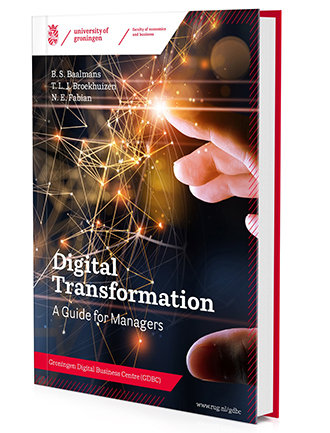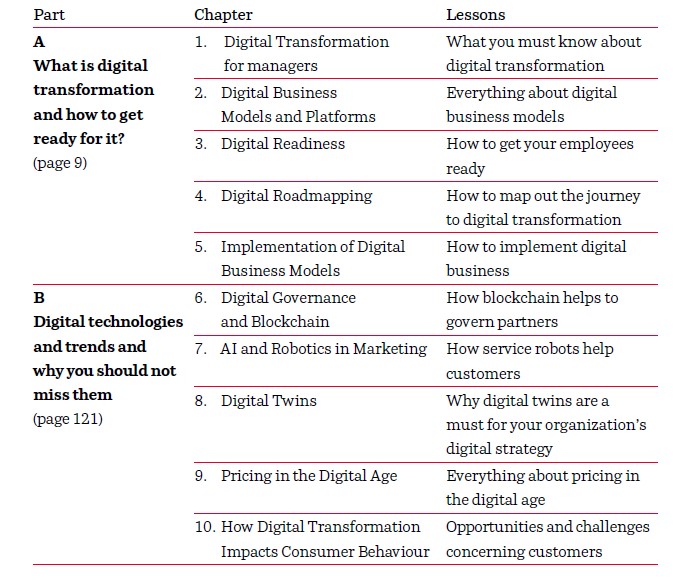Digital Transformation: A Guide for Managers

GDBC's book 'Digital Transformation: A Guide for Managers' tries to address the apparent gap in knowledge on how digital transformation and digital technologies are reshaping value creation and value capture. As academics, we are working at the forefront of knowledge, always with the goal in mind that our work can inspire decision-makers. What we realized was that oftentimes our academic outlets are not reaching practitioners in time and are oftentimes written in a way that is not easy to comprehend. Especially for a topic such as digital transformation where changes happen at an ever-increasing speed, this poses challenges. Thus, a key goal of this book is to make state-of-the-art knowledge accessible to practitioners. A second motivation for us is that academics typically work within their disciplines such as marketing, strategic management, or information systems and rarely cover and integrated insights from multiple research fields. However, digital transformation with its deep changes requires an interdisciplinary approach instead ofperspectives from one single domain. Thus, our book also provides insights from experts from a variety of domains.
Download the book in PDF.
This book is structured into two main parts, each part containing five chapters. View the table to get an overview of the topics discussed in each chapter.

Click on the chapter titles below to get a more detailed description of the chapter and watch an animation summarizing the chapter.
Authors: Nicolai Etienne Fabian, John Qi Dong, Abhi Bhattacharya
Digital transformation puts enormous pressure on companies to become more digital. By incorporating digital technologies, companies can generate value for their customers in fully new ways. The key to such value creation is the utilization of new digital business models. Depending on the circumstances, firms might offer a part of their products for free, change to a service-driven business model, or create a platform. However, digital transformation remains inherently risky and business model transformation is time-consuming and costly. Managers need to be aware of several pitfalls such as changing organizational structure, culture, and leadership. Moreover, in the transformation process roles of employees also change and some might even show resistance to digital transformation initiatives.
In this book chapter, we discuss digital transformation, digital business models, and potential pitfalls and provide practical guidance for managers. This chapter provides managers with a broad overview of research on digital transformation and accounts from practice.
Chapter 2: Digital Business Models and Platforms
Authors: P.K. Kannan & Simratpal Singh
This chapter illustrates the role of digital technologies in the evolving digital environment and the new business models that are being created in that environment as new digital technologies emerge. The chapter describes the evolution of different types of platform models including search engine platforms, social media and chat platforms and e-commerce platforms and shows how businesses can use these models to their advantage. The chapter also discusses the metaverse as a new form of platform model. The chapter outlines how the notion of product is servicitized through digital services. This opens up opportunities for Internet of Things (IoT) models through networked services and rental models. The development of new pricing models is explored through a discussion of freemium models and subscription models. The chapter then provides pointers for businesses seeking to adopt these models.

Authors: Khoi Nguyen & Thijs Broekhuizen
While human capital is crucial to digital transformation, little is known about employee digital readiness, and how this may foster digital transformation. This chapter conceptualizes employee digital readiness and postulates its drivers and consequences.
Based on a literature review, we highlight two distinct patterns that promote psychological and behavioral outcomes of digital readiness. The psychological pattern suggests that firms can reduce technological anxiety by providing organizational support that enhance employee’s capability. The behavioral pattern shows that in order to improve effective use, firms should enhance collegial support and enhance the appropriateness of digital tools, which will increase the usefulness of digital transformation. Finally, we introduce a team perspective and conceptualize how employee digital readiness affects outcomes by relating the focal member’s digital readiness to the team’s digital readiness. We hypothesize possible psychological and behavioral outcomes based on whether the focal employee and team have high or low readiness, and suggest remedies in case of (mis)fit situations.

Authors: Thijs Broekhuizen & David Langley
Developing digital roadmaps help managers to explore and determine the direction of digital transformation for their organizations. The act of developing a systematic digital roadmap fosters an understanding of the purpose of digitalization, how to attain digital skills and resources needed to attain the digital transformation goals, and drives organizational change in a coordinated and effective way. Digital transformation is a risky and uncertain journey, full of unexpected events, where important decisions rely on imperfect information.
Although planning may seem ineffective in such uncertain and highly volatile settings, we argue that digital roadmapping can be an important first step for success. While the desired destination and strategies will differ per firm, carefully developing a roadmap - involving the definition of goals, the exploration of alternative paths, and the implementation and validation of selected digital initiatives - will help organizations to progress in their digital transformation journey in an effective and impactful manner.

Authors: Albert Boonstra & Marjolein van Offenbeek
This chapter proposes a diagnostic framework that guides managers in developing a situationally appropriate and tailored implementation strategy for digital business. We distance ourselves from the view that there is one way of implementing digital business that will be effective in all circumstances. Rather, we clarify how an implementation strategy for digital business depends on the characteristics of the digital technology, the stakeholders involved, and the organizational context in which the digital business system is implemented.
Based on this insight, we propose a diagnostic framework for the implementation of digital business. The framework helps managers reflect on the complexity and risks involved from four domains of the digital business project and guides them in consciously developing a suitable implementation strategy. The framework identifies four generic types of digital business projects (uniform, pluriform, unfolding, and ambiguous) and proposes implementation strategies that match these types.
The framework supports an open dialogue with primary stakeholders to develop a shared understanding of project characteristics and align them with an appropriate strategy. It will help managers develop a deeper understanding of their project early on and in the course of the project, resulting in more tailored and flexible implementation trajectories.

Authors: Marvin Hanisch, Vasileios Theodosiadis & Filipe Campos Silva Teixeira
Digital technologies are changing the business world at a rapid pace, bringing new challenges and opportunities for companies. This is especially true for blockchain technologies, which are increasingly being used to manage interorganizational transactions. Blockchains are distributed ledger technologies where data is replicated, shared, and synchronized over a network of computers without central servers.
The main advantages of blockchains over standard contracts are that they are particularly secure, easily scalable, and comparatively inexpensive. At the same time, blockchains also present managers with a number of challenges in terms of network participation rules, control mechanisms, technology choices, and legal affairs. In this book chapter, we discuss these aspects and provide practical guidance for decision-makers. This discussion makes it easier for managers to determine whether and under what conditions blockchains offer an advantage for their business.

Authors: Jana Holthöwer & Jenny van Doorn
This chapter illustrates the role of artificial intelligence (AI) and robotics in marketing and will help managers develop a deeper understanding of its potential to revolutionize the service experience. We summarize the use of AI and robots in practice and show that the adoption of AI predominantly occurs at the task level rather than the job level, implying that AI takes over some tasks that are part of a job and not the entire job.
Based on these insights, we discuss opportunities and drawbacks of AI and robotics and reflect on whether service robots will complement or substitute human employees. Moreover, we explain why many consumers are still reluctant to engage with these new technologies and which conditions should be met in order to benefit from using service robots.

Authors: Andrés Tello & Viktoriya Degeler
Digital Twins are a virtual representation of anything of value for an organization that create a link between the real and virtual worlds by a continuous bidirectional data/information exchange. In this chapter we present the origins of the concept and how it evolved with the advent of new technological trends. In addition, we describe the main characteristics of a Digital Twin, the benefits of its use, and real-world examples of the usage of digital twins’. Finally, the challenges for its adoption, and the elements to be considered for managing the quality of the Digital Twin are presented to give a complete overview of this new technology.
Author: Arnd Vomberg
Dynamic pricing and personalized pricing emerged as novel pricing approaches in the digital age. Shifting to these novel pricing approaches can increase company profits by 3% to 25%. Dynamic pricing allows firms to smoothen demand and supply and to remain competitive facing price pressure. Personalized pricing enables companies to tap into consumers’ differing willingness to pay.
However, such profit-increases only set in if managers make good choices when implementing their company’s pricing approach. Managers need to overcome potential adverse consumer reactions and need to comply with privacy regulations. Managers need to create an appropriate IT infrastructure, synchronize prices in their on- and offline channels, harmonize prices in their product portfolio, and nurture a mindset that is open to automating prices.
This book chapter discusses these aspects and provides practical guidance for decision-makers. This discussion enables managers to decide whether and how to implement a dynamic pricing approach.

Authors: Lisette Kruizinga & Lisan Lesscher
This chapter discusses digital transformation from a consumer perspective. The digitalization affects consumers since the ways of communicating, gathering, and exchanging information about products and/or services, and obtaining and consuming them, drastically changed. Think of buying online, easily searching online and comparing product offerings from different suppliers and writing & reading online reviews. Also, consumers are empowered by new media to promote and distribute their own offers. Hence, this alsoaffected firms, as they had to change their business models to adapt to these changing needs. This led to multi-channel and finally omni-channel management.
Digitalization and new media have made it possible for consumers to not only be passive recipients of firm communication, but also to actively communicate with firms and with each other. So, from unidirectional firm to consumer communication, communication becomes multidirectional. However, traditional marketing communication tools have not disappeared and remain relevant. Different studies have shown that also in this new digitalized world, traditional media remains an effective medium to influence consumers, next to new media.
The chapter further discusses some examples from practice. For example, At DVJ we developed a new KPI that represents contacts that brands have with consumers. This so-called RPS enables us to compare different media directly with each other. The chapter concludes with different success stories of firms that succeed in utilizing digitalization to their advantage and surprise consumers every day.

| Last modified: | 06 December 2022 5.15 p.m. |

